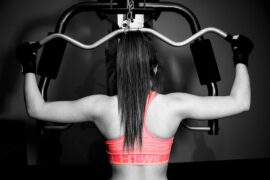Come on ‘fess up, how many pairs of trainers do you own? And taking away any fashion based trainers, out of the ones you have left, which ones can you hand on heart say are really up to the job?
The question of whether a pair of trainers really makes that much of a difference to your running, is one that gets asked a lot. And is it any wonder that many of us are left feeling overwhelmed when we’re faced with such a seemingly infinite choice.
Do you get what you pay for?
Do I need cushioning?
What about grip?
I’ve been running for almost a year now and it’s only very recently that I’ve bought what I would call a ‘decent’ pair of trainers. My first pair were some cheap and cheerful Karrimor; they cost me less than thirty quid and I figured they’d be fine considering I wasn’t even entirely sure I would stick at this running lark. My run leader was constantly on at me to ‘invest’ in a decent pair, but because I’m a stubborn so-and-so and because I wasn’t suffering from any injuries or pain from running in them, I stuck to my guns and the Karrimor lived to run another day.

Roll forward 9 months, I’m still running, but it’s colder, darker, muddier and slippier, and my Karrimor are frankly looking past their best. I knew it was time to let them go and think about buying a new pair.
But where to start?
Pretty much every trainer out there promises to be the pair you need; the BEST, but there is never a one trainer fits all. A shoe, just like a pair of glasses, is a prescription and there are certain things you have to take into consideration before you part with your hard earned cash.
What Will You Use Them For?
First up you need to think about the surface that you’re running on. Do you mainly run on the road or do you tend to go off track, through fields and woods? Or perhaps you do a mixture of both? Either way, the surface you run on directly relates to the amount of tread and cushioning that you will require from your trainers.
If you’re mainly running on pavements, road or other hard, concrete type surfaces than road trainers are likely to be the ones for you. These will have more cushioning for greater shock absorption and less grip. Alternatively, if you run on softer, more uneven ground such as fields, then you’re far better off with a pair of trail trainers. These tend to have a deeper tread to improve grip and stability as well as greater ankle support to help with the uneven terrain.
And if you like to mix it up a bit and do both road and off road, then you might want to consider a hybrid trainer that has a balanced mix of grip and cushioning.
How Much Support Do You Need?
As you probably may have gathered from reading the above, much depends on the type of surface you are running on, and this is closely tied in with the level of support you will need. However, there are other factors, such as bodyweight, pronation and whether you have any existing injuries or joint problems, that will also play a part in ascertaining the degree of support required from a trainer.
 Cushioned trainers are at the lower end of the support spectrum, offering a very mild level of support to people who are fortunate enough to have a neutral foot type i.e. one that doesn’t pronate (more on this later!). They are a lighter shoe, owing to the fact they have less material and less ‘features’ on them, which is great for seasoned runners who are looking to increase their speed. They are not recommended for runners who weigh over 13 stone in weight, as they don’t offer enough support to cover the level of impact forced upon the muscles and joints of the lower leg in someone of this weight.
Cushioned trainers are at the lower end of the support spectrum, offering a very mild level of support to people who are fortunate enough to have a neutral foot type i.e. one that doesn’t pronate (more on this later!). They are a lighter shoe, owing to the fact they have less material and less ‘features’ on them, which is great for seasoned runners who are looking to increase their speed. They are not recommended for runners who weigh over 13 stone in weight, as they don’t offer enough support to cover the level of impact forced upon the muscles and joints of the lower leg in someone of this weight.
The next level up is to go for a structured cushioned or a stability trainer. These offer a combination of cushioning; the amount will vary between brands, and motion control. This category of trainer is by far the most popular, mainly due to the versatility of them, however it is still absolutely crucial to seek expert help to narrow down your choices, as there are still so many other factors involved in the trainer selection process.
And at the very top of the support category we have the maximum support trainers, the ones that are made of higher density materials to offer the ultimate in support, cushioning and control.
To really understand how much support you need from a trainer, you should ask the experts. In truth it’s the only way to fully establish what it is you personally need from sports footwear. Yes you could hazard a guess based on certain criteria, but you may end up spending a lot of money on a pair of trainers that at best allow you to run without pain, but at worst could be doing you a lot of damage in the longer term.
What Size Are You?
Turns out that whatever size you are for the regular shoes you wear day-to-day, won’t necessarily be the same size you need in running trainers. Think about it: when you run, your foot moves, which means it needs more space to move and change position. Therefore most experts recommend that you allow a bit of extra room in your trainers to accommodate this. And it’s not just the length of your foot; it’s the width too. Some brands and styles will come up narrower than others, so it’s always worth trying on a selection until you find the perfect fit.
Did you know that your feet change size throughout the day? The more you use them, the more they swell so it’s a good idea to try on new trainers either late afternoon or in the evening.
What Socks Do You Wear?
If you’re anything like me, you probably don’t even think twice about the socks you’re wearing when you run, I mean it’s the trainers that actually count, right?
Wrong!
Yes it’s the trainers that protect and support your feet, but let’s not forget about the interior comfort factor as well, and that can depend a lot on what socks you wear. Sports socks are generally a bit thicker than standard socks and are made of a more absorbent material to help with comfort and freshness (basically it helps soak up the sweat!) and you can even get some that are custom designed to match up with a particular trainer design or brand.
One important thing you must always remember is that whenever you try on a new pair of trainers you should make sure to wear the socks that you intend to run in, as this can vastly affect how a trainer feels and fits.
Do You Pronate?
If you pronate it means you walk or run with most of your weight on the inside edge of your foot. It is this rolling movement that causes runners so much grief and is one of the biggest causes of injury, but wearing a correctly fitting pair of trainers can sort this right out.
There are varying degrees of pronation and there is a trainer out there to help with each and every one, but how on earth do you go about finding out how much you pronate?
You can have a biomechanical assessment done that’s what!

Most specialist running stores will offer this service and although techniques may differ, ultimately it is the same in that it is an assessment of the mechanics of your body with the aim of finding a pair of trainers that will improve, correct and enhance how you move and run.
The best way to assess how someone runs is to use technology such as video gait analysis and specialist software that can capture the body in slow motion, frame per frame, revealing in minute details exactly how the leg, joints, muscles and feet move and position themselves with each step.
To find out more about how a biomechanical assessment can help you find the perfect pair of running trainers take a moment to read my review of my biomechanical assessment at Alexandra Sports.
So to answer the questions at the start of this post:
Do you get what you pay for?
In short yes. Better, stronger, more supportive materials inevitably cost more money, but think of it as an investment. Plus the more you run in them, the more the cost per wear goes down. Now that’s some running motivation for you right there!
Do I need cushioning?
Probably, but it all depends on your feet. Get assessed.
What about grip?
It all depends on what surface you intend to run on.
Does having the right running trainers really make any difference?
Yes, it absolutely does!
I now own a decent pair of running trainers that fit me properly, that offer me the right level of support, that I feel confident running in and that look pretty swish too (‘cos that counts!). Oh and I also have a much happier run leader now those old Karrimor have been ditched, which might mean she’ll take it a bit easier on me now…or maybe not!

What’s Your Experience With Running Trainers? Do You Have A Favourite Brand? Have You Had A Biomechanical Assessment?
We’d love to hear from you, so get in touch!
You can comment and follow us on:
- Facebook – @thisishealthyliving)
- Twitter – @ArtHealthLiving
- Instagram – @arthealthyliving
Or leave us a friendly comment below ?
































